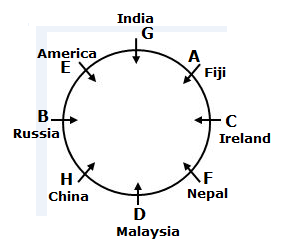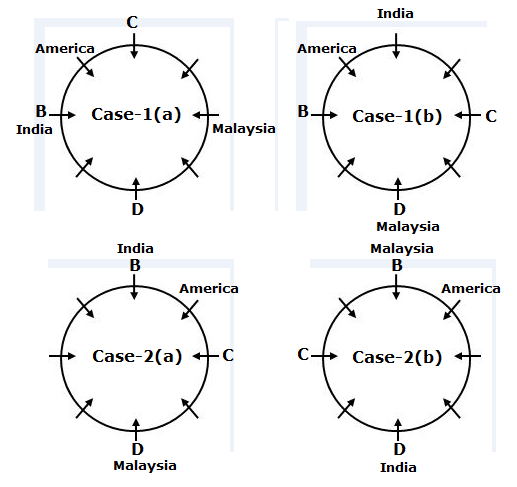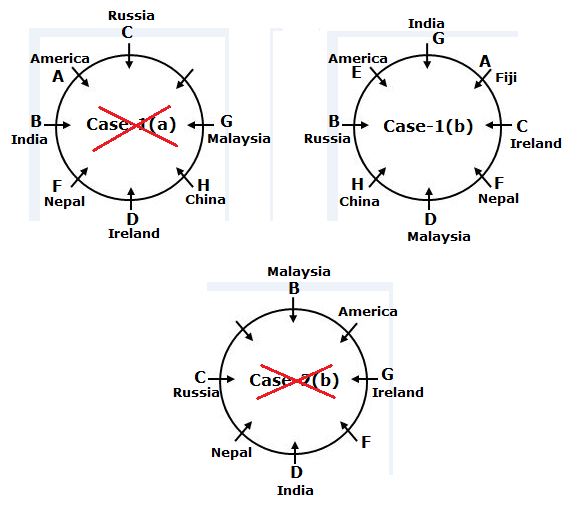Dear Aspirants, Our IBPS Guide team is providing new series of Reasoning Questions for LIC AAO/SBI PO 2019 so the aspirants can practice it on a daily basis. These questions are framed by our skilled experts after understanding your needs thoroughly. Aspirants can practice these new series questions daily to familiarize with the exact exam pattern and make your preparation effective.
[WpProQuiz 5840]
Click Here to Take LIC AAO Prelims Mock Test
Click Here for SBI PO Pre 2019 High-Quality Mocks Exactly on SBI Standard
Click Here to View Reasoning Questions in Hindi
Direction (1-5): Read the following information carefully and answer the questions given below.
Eight persons A, B, C, D, E, F, G and H are sitting in a circular table with equal distance from each other and all of them are facing centre of the table. They all are belongs to different countries viz., Ireland, Malaysia, China, India, Nepal, Fiji, Russia and America but not necessary in the same order.
Only two persons are sitting between D and the one who belongs to America. B sits immediate right of the one who belongs to America. The one who belongs to India sits second to the right of C, who is not an immediate neighbour of both B and D. The one who belongs to Ireland sits immediate right of F, who is an immediate neighbour of D. The one who belongs to Nepal sits third to the left of G. H belongs to China, who faces A. E sits second to the right of A. The one who belongs to Russia faces the person who belongs to Ireland. Three persons are sitting between the one who belongs to India and the one who belongs to Malaysia.
1) A belongs to which of the following countries?
a) Russia
b) India
c) Ireland
d) Fiji
e) Nepal
2) How many persons are sitting between F and the one who belongs to China, when counted in clockwise direction from F?
a) One
b) Two
c) Three
d) None
e) More than three
3) Which of the following statements is true?
a) G sits second to the right of the one who belongs to Russia
b) Only two persons are sitting between C and D
c) E faces the person who belongs to Nepal
d) B faces the person who sits to the immediate right of A
e) None is true
4) If F is related to Fiji and H is related to Nepal in a certain way. Then, G is related to which of the following?
a) India
b) Russia
c) Ireland
d) Nepal
e) America
5) Four of the following five are alike in a certain way and hence form a group. Which one of the following that does not belong to the group?
a) E-Nepal
b) C-Russia
c) H-Fiji
d) D-America
e) G-Malaysia
Direction (6-10): In the following questions, the symbol @, #, $, % and & are used with the following meaning as illustrated below.
Give answer if,
a) Only conclusion I follow
b) Only conclusion II follows
c) Either conclusion I or II follows
d) Neither conclusion I nor II follows
e) Both conclusions I and II follows
‘A@B’ means ‘A is neither smaller nor greater than B’,
‘A#B’ means ‘A is not greater than B’,
‘A$B’ means ‘A is not less than B’,
‘A%B’ means ‘A is neither greater than nor equal to B’ and
‘A&B’ means ‘A is neither smaller than nor equal to B’.
6) Statements:
D&T$U@N%V; M#K%T$A$Q.
Conclusions:
I. N#M
II. Q%D
7) Statements:
G$C%S#E@W; L@K#E%A$V.
Conclusions:
I. A&C
II. S#L
8) Statements:
P@R&O$J#W; S$M&B@R#L.
Conclusions:
I. M&W
II. J#L
9) Statements:
Q#X@Z%R$E; G$N%M%U@R.
Conclusions:
I. Q%U
II. N%E
10) Statements:
Y&V$A$P@U; N#F@U&K$S.
Conclusions:
I. A$N
II. K%V
Answers :
Direction (1-5):

Only two persons are sitting between D and the one who belongs to America. B sits immediate right of the one who belongs to America.

The one who belongs to India sits second to the right of C, who is not an immediate neighbour of both B and D. Three persons are sitting between the one who belongs to India and the one who belongs to Malaysia.

The one who belongs Ireland sits immediate right of F, who is an immediate neighbour of D. The one who belongs to Russia faces the person who belongs to Ireland. The one who belongs to Nepal sits third to the left of G.
So, Case-2(a) will be dropped.

H belongs to China, who faces A. E sits second to the right of A.
So, Case-1(a) and Case-2(b) will be dropped.

1) Answer: d)
2) Answer: a)
3) Answer: c)
4) Answer: b)
5) Answer: d)
Direction (6-10) :
6) Answer: b)
I. N≤M –> N=U≤T>K≥M
II. Q<D –> Q≤A≤T<D
Only conclusion II follows
7) Answer: a)
I. A>C -> A>E≥S>C
II. S≤L -> S≤E≥K=L
Only conclusion I follow
8) Answer: d)
I. M>W –> M>B=R>O≥J≤W
II. J≤L –> J≤O<R≤L
Neither conclusion I nor II follows
9) Answer: a)
I. Q<U –> Q≤X=Z<R=U
II. N<E –> N<M<U=R≥E
Only conclusion I follow
10) Answer: e)
I. A≥N –> A≥P=U=F≥N
II. K<V –> K<U=P≤A≤V
Both conclusions I and II follows





